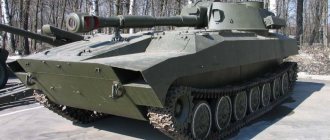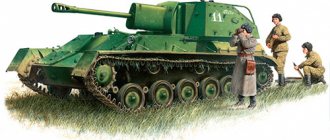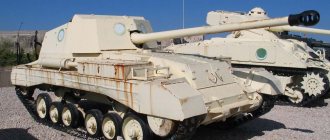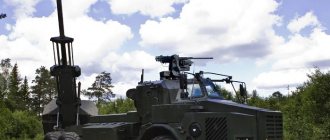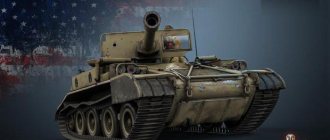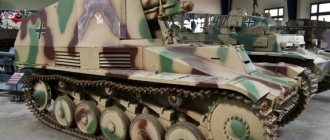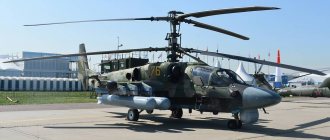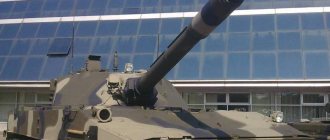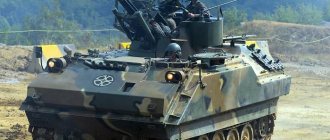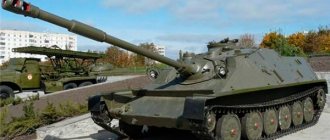8.8 cm Pak43 (Panzerabwehrkanone 43) is a German 88-mm anti-tank gun developed jointly with Renmetall based on the 8.8 cm Flack 41 anti-aircraft gun. 8.8 cm Pak43 was the most powerful anti-tank gun, massively used by the Wehrmacht at the front. In addition to towed artillery, the cannon was installed in the Tiger II tank, as well as in self-propelled artillery - self-propelled guns Elephant, Jagdpanzer and Noshorn. Within a kilometer, the gun provided an almost flat trajectory and could hit the frontal armor of tanks at a distance of up to 2.5 km.
Grade.
The 8.8 cm Pak43 was the most powerful wartime anti-tank gun, with the exception of the 12.8 cm Pak 80 which was never mass produced. The Allied guns BS-3 and 17-pounder, which were closest in terms of performance characteristics, were inferior to it in terms of armor penetration. Soviet designers failed to surpass the ballistics of the 8.8 cm Cancer 43 both during the war and after. Not a single tank, including the Soviet IS-2, provided effective protection from its shells. Thanks to the use of the excellent artillery tractor Sd.Kfz. 7 gun had satisfactory tactical mobility.
Self-propelled guns for the doomed
In July 1944, the Nibelungenwerke plant put into serial production a new heavy self-propelled gun based on the Pz.Kpfw.VI Ausf tank. B "Tiger II" ("Royal Tiger"). The first series of “Jagdtigers” (as the new self-propelled guns were called) included self-propelled guns with both a chassis designed by Dr. Erwin Aders (chief engineer) and a chassis designed by Dr. Ferdinand Porsche
In 1941, the battles on the Eastern Front revealed one fact that became very unpleasant for the Wehrmacht. It turned out that the level of development of Soviet technology significantly exceeded what was expected - this was especially evident when German troops collided with the latest tanks and T-34s, the armor of which was difficult for most standard anti-tank weapons to penetrate. The real salvation in the fight against these giants turned out to be the 8.8-centimeter (in Germany, the caliber of artillery systems is traditionally measured in centimeters) FlaK 36 anti-aircraft guns and their other modifications - FlaK 37 and FlaK 18. Only the armor-piercing shells of these anti-aircraft guns, accelerated by powerful powder charges to initial speed of 820 m/s, could penetrate the 75-mm armor of the KV or pierce the 45-mm forehead of the "thirty-four". The German units called these guns “eight-eight” and tried to transfer them to the most tank-dangerous areas of the front.
The designers of the Krupp corporation developed the FlaK 18 back in 1928, and the first prototypes were assembled outside Germany - at a Swedish plant. This was due to the restrictions on arms production imposed on Germany after the end of the First World War. The Krupp factories in Essen began independently assembling these artillery systems only in 1932.
Artillerymen of the Wehrmacht Afrika Korps preparing an 88-mm FlaK 36 anti-aircraft gun for firing, 1940–41 Source – waralbum.ru
In 1940, the designers created the 88-mm FlaK 36 gun, which was equipped with wheeled carts for quick movement, as well as an electric trigger and an armored shield to protect the crew from bullets and shrapnel when firing at ground targets. In fact, this weapon was created as a universal means of fighting against enemy aircraft and tanks.
A serious drawback of the 88-mm anti-aircraft guns was their high target silhouette and significant cost - the price to pay for versatility. The Wehrmacht Armament Directorate (hereinafter referred to as the Wehrmacht) demanded that the designers create a cheaper anti-tank gun based on the FlaK 36, which was carried out at the end of 1942 by the Krupp corporation.
The new 88-mm Pak 43 gun turned out to be one of the best anti-tank artillery systems of the Second World War (hereinafter referred to as WWII). Its 71-caliber barrel made it possible to accelerate armor-piercing shells to a speed of 1000 m/s, and sub-caliber shells to 1130 m/s. Thanks to this, the Pak 43 could hit almost any Soviet tank from a distance of two kilometers.
German artillerymen deploy an 88-mm Pak 43 anti-tank gun Source – waralbum.ru
Tables of armor penetration when firing from an 88-mm Pak 43 cannon at a shell-to-armor angle of 60°, mm | ||
| Range, m | Caliber armor-piercing projectile Panzergranate 39/1, 39/43 & 39/43 Al | Panzergranate 40/43 tungsten-cored sub-caliber armor-piercing projectile |
| 100 | 203 | 237 |
| 500 | 182 | 217 |
| 1000 | 167 | 193 |
| 1500 | 153 | 171 |
| 2000 | 139 | 153 |
| 2500 | 127 | no data |
The main disadvantage of this anti-tank gun was its high weight - 4.4 tons. Therefore, if the gun crew entered into battle, then changing position or retreating became a serious problem. The low mobility of such a successful artillery system could not help but lead the designers to the idea of installing it on an armored chassis.
The installation of the Pak 43 gun on the first German serial heavy tank Pz.Kpfw.VI "Tiger" turned out to be impossible due to the latter's significant dimensions. Therefore, in 1942, the armored “predator” was armed with a KwK 36 tank gun of the same caliber (88 mm), but of shorter length - only 4.9 meters versus 6.2. Naturally, the ballistics of this gun were worse than those of the KwK 43 and StuK 43 (guns created on the basis of the Pak 43 for installation on tanks and self-propelled guns, respectively), but it was quite enough to knock out the Soviet KV-1 and T-34.
StuK 43 was installed on heavy anti-tank self-propelled guns (or, as they were called in the Wehrmacht, “Jagdpanzers”) “Ferdinand”. They converted the chassis of the Tiger (P) tank designed by Ferdinand Porsche, which the industry hastened to produce on Hitler’s personal order even before the USV adopted the Tiger designed by the engineers. In the Austrian city of St. Valentin, armored conning towers with monstrous frontal armor of 200 mm were built over the chassis. The StuK 43 was placed in the wheelhouse, receiving a self-propelled gun, which became one of the most terrible opponents of the Soviet troops in the Battle of Kursk. Fortunately for Soviet tankers, the German industry produced few Ferdinands - only about 90 units. In addition, the chassis of these self-propelled guns turned out to be quite unreliable, and the vehicles were let down by the lack of machine gun armament, as a result of which the self-propelled guns became defenseless in the event of close combat against infantry. Therefore, despite powerful armor and armament, a significant number of these vehicles were lost in the battles of the summer of 1943.
Self-propelled gun "Ferdinand" with an 88-mm StuK 43 cannon in the armored tank museum in Kubinka Source – tankmuseum.ru
German designers took into account the experience of using heavy Jagdpanzers, and in July 1944, at the same Nibelungenwerke enterprise, they launched into mass production a new heavy self-propelled gun, created on the basis of the Pz.Kpfw.VI Ausf tank. B "Tiger II" ("Royal Tiger"). It is curious that this time the story with prematurely manufactured chassis for tanks designed by Porsche repeated itself, only now they were assembled not 100 pieces, but only 7. The first series of “Jagdtigers” (as the new self-propelled guns were called) included self-propelled guns with a chassis designed by Dr. Erwin Aders (chief engineer and head of new developments), and with a chassis designed by Dr. Ferdinand Porsche. Subsequent vehicles were produced only on a chassis designed by Aders, but very few of them, like the Ferdinands, were assembled. The total number of Jagdtigers produced is estimated at approximately 70–88 units, the weight of each of which reached 75.2 tons - the Jagdtigers became the heaviest of all production German armored vehicles. For comparison, the mass of the “Royal Tiger” reached 68 tons, and the modern German tank “Leopard-II” A5 weighs 62 tons.
High-ranking representatives of the Wehrmacht and (Erwin Aders - in a dark suit on the right), September 5, 1942 Source - pokazuha.ru
The Jagdtiger had a standard German layout - in front was the control compartment with a transmission installed in it, behind it was the fighting compartment, located in the wheelhouse and the middle part of the hull. In the stern there was an engine compartment with a V-shaped 12-cylinder four-stroke liquid-cooled carburetor engine produced by the HL 230 P30 model. The working volume of the power plant reached 23,095 cm³, and it developed a maximum power of 700 hp. With. at 3000 rpm. However, the weight of the self-propelled gun for such an engine was too large, so on the highway the self-propelled gun reached a speed of no more than 38 km/h, and on rough terrain - 17 km/h.
Assembly shop with hulls of Jagdtigers undergoing assembly Source – weaponscollection.com
The thickness of the upper frontal plate at the Jagdtiger's wheelhouse reached 250 mm, the hull - 150 mm, and the lower armor plate - 120 mm. Both armored parts of the hull were located at an angle of 50°. German designers protected the sides and stern of the self-propelled gun with an 80-mm layer of steel, the bottom and roof of the hull with 40 mm, and the deckhouse roof with 45 mm. It is interesting that the frontal armor plates of the wheelhouse were made from pre-war armor, which was taken from Kriegsmarine stocks.
In 1944, they planned to assemble 150 Jagdtigers, but these plans were not destined to come true. On October 16, 1944, Allied aircraft subjected the St. Valentin plant to a massive bombardment, dropping about 143 tons of bombs. Production at the enterprise was partially restored, but it was no longer able to fulfill the state order in full. They tried to get out of the situation by transferring part of the order located in Jungenthal, but even there the actions of enemy aircraft thwarted all plans.
View of the tank building workshop after the bombing by Allied aircraft on October 16, 1944. In the foreground are the damaged hulls of the Jagdtigers Source – waralbum.ru
Initially, all “Jagdtigers” were armed with a powerful 128-mm Pak 80 gun. This gun was very heavy, so it was mounted not in the frontal sheet of the cabin (it simply could not withstand excessive load), but on a specially designed stand installed on the floor of the fighting compartment. The gun had a large number of shortcomings - in particular, its recoil was so significant that the self-propelled gun could only fire from a standing position, otherwise its chassis risked failure. If, on the march, the gun was not secured to a special rack, then the swaying of the barrel could at least cause the guidance mechanism to become misadjusted, and at most, to fail. But the biggest drawback of the Pak 80 guns at the beginning of 1945 was their shortage - there was simply nothing to install on the new tank chassis.
Engine compartment of the Jagdtiger Source – scalemodels.ru
On February 26, 1945, Hitler issued an order according to which the production of the Jagdtiger self-propelled guns received the highest priority. With the next order, he demanded the transfer of all stocks of 128 mm barrels. It was also prescribed to send 128-mm towed Pak 44 cannons on carriages there. In case of a shortage of 128-mm artillery systems, enterprises should have used 88-mm tank KwK 43/3 and StuK 43/3, installed on the “Royal Tigers” and the Jagdpanther self-propelled guns, or even the Pak 43/3 L/71 anti-tank guns.
In March 1945, only three Jagdtigers were assembled in St. Valentin, which was caused primarily by a shortage of barrels. In April, out of seven self-propelled guns produced, four vehicles with chassis numbers 305078, 305079, 305080 and 305081 were armed with 88 mm cannons. By May 4, the plant had produced the last three vehicles with chassis numbers 305082, 305083 and 305084, for which 128 mm guns were found.
"Jagdtiger" with a 128-mm Pak 80 gun in the stowed position Source - russkiytankist.3dn.ru
By this time, tank crews from two units arrived at the plant to receive new vehicles - the 1st company of the 653rd heavy tank destroyer battalion (commanded by Lieutenant Hans Knippenberg) and the 501st SS heavy tank battalion, led by Untersturmführer Waldemar Warnecke. Self-propelled guns lost their vehicles in the spring battles in Germany and the Benelux countries (where the forces of the 653rd battalion were dispersed into groups of several vehicles each to support infantry units), and the 501st battalion lost almost all of its material (only four vehicles) during the unsuccessful March offensive in the area of Lake Balaton.
There is no reliable information about what kind of guns the “Jagdtigers” that ended up in one or another unit were armed with. Researcher Andrew Devey in his book “Jagdtiger Der stärkste König” claims that the SS received the last four vehicles produced at the factory and equipped with 128 mm guns, while the remaining vehicles, including the 88 mm KwK43/3 Jagdtiger, received self-propelled gunners of the 653rd battalion. However, after the surrender of Berlin on May 1, the command of the army battalion disbanded it, so the crews, in accordance with the order, blew up their vehicles and went home.
The SS tankmen were not happy with this outcome of the war, and Soviet troops were already approaching St. Valentin, from whom nothing good could be expected, since the Red Army soldiers tried not to take SS soldiers prisoner. Therefore, the crews of the remaining Jagdtigers independently refueled their vehicles, loaded them with ammunition and moved west to break through to the Allied positions and surrender there. The tankers abandoned two vehicles along the road due to the failure of their chassis. They blocked the bridge with another “Jagdtiger” to make it difficult for the Soviet units on their heels to pass, and a single vehicle with all the SS crews on armor drove out to the Americans. Thus, not a single 88-mm Jagdtiger self-propelled gun took part in the hostilities.
Figure “Jagdtiger” 8.8 cm Pak 43/3 Source – world-of-tanks.eu
In 1996, the archaeological society Simonides Military Archaeology Group announced that its members had discovered the remains of a Jagdtiger with chassis number 305081 in Poland. Searchers did not find traces of a gun, but they found a special one in a standard mask for the 128-mm Pak 80 gun steel liner used to install a smaller diameter barrel. Amateur archaeologists have not yet provided any photographs to confirm their words.
Crew training
The vehicle has a crew of six people. This is very good, because with the help of perks you can increase the parameters of the tank, and therefore the comfort of the game.
We propose to train the crew in the following order:
- Commander – “The Sixth Sense”, “Repair”, “Combat Brotherhood”, “Disguise”;
- Gunner – “Repair”, “Smooth rotation of the tower”, “Combat brotherhood”, “Disguise”;
- Driver mechanic – “Repair”, “Smooth ride”, “Combat brotherhood”, “King of off-road”;
- Radio operator – “Repair”, “Radio interception”, “Combat brotherhood”, “Disguise”;
- Loader – “Repair”, “Non-contact” ammunition rack, “Combat brotherhood”, “Disguise”;
- Loader – “Repair”, “Desperate”, “Combat Brotherhood”, “Disguise”.
Equipment for 8.8 cm Pak 43 Jagdtiger
The choice of consumables is a responsible matter, but it operates according to an almost universal scheme. If you feel a lack of silver, take a set consisting of:
- small first aid kit;
- small repair kit;
- hand fire extinguisher.
If we have the opportunity to take premium consumables, we take them:
- large first aid kit;
- large repair kit;
- chocolate (you can also take an automatic fire extinguisher if you are afraid of not protecting the NLD and the stern)
Game Tips
And so, the first thing you should do when meeting a fast enemy such as a medium tank is to shoot at his caterpillar. If you don't do this, then an experienced player will simply run into your stern and kill you. We don’t have the dynamics of a French tank destroyer, and any medium tank can spin us around. It is also worth noting that if your goal is to farm as much silver as possible, and not to pump up the crew, then you should deal as much damage to your opponents as possible. Fortunately, accuracy and rate of fire allow us to do this perfectly.
There are many key points for tank destroyers on various maps, I will give two examples. The first map is Highway.
Square E9 gives us a lot of opportunities to realize ourselves in battle. In this square there is a bush that perfectly hides us from enemies. It is worth saying that we can only be exposed to light from the H line and only with additional optics. This is an ideal position for gaining damage in battle.
The second map is Murovanka.
There are just a lot of bushes in square H2, so you will remain unnoticed even after shooting at a passing enemy. This position is very useful for defending any direction, as well as protecting your base and allied artillery from enemy fireflies.
Such points are also present on other maps and you can find them by analogy.
gun
If we compare one-time damage with other premium vehicles, we get a fairly standard result: 240 units. The rate of fire here is pleasing - 11.76 rounds per minute. From here we get an excellent result of damage per minute - 2,823 units/min.
Always remember that this is a premium tank, then the armor penetration indicator will not seem weak - 212/237/44 mm. Here you should always target the weak parts of the enemy’s equipment and carry some gold with you - it will never be superfluous.
The gun is accurate, and that's a fact. Ignoring stabilization, which is poor in all tank destroyers, we get an excellent spread of 100 meters - 0.31 m and aiming time of 1.80 seconds.
After the joyful accuracy indicators, we remember about the uncomfortable UVN and UGN. The gun here drops only 7 degrees, you can live with this, you can still play comfortably, but with the UGN things are worse. Only 20 degrees are available, as well as poor maneuverability and large dimensions.
Ammunition and armor penetration[edit]
Pak 43 in the back
Pzgr. 39/43 and high explosive shells were generally available. Pzgr. 40/43 were in acute shortage.
Pzgr. 39/43 APCBC-HE[edit]
- Type: Armor Piercing Cap with Ballistic Cap - High Explosive
- Projectile weight
: 10.4 kg (22.92 lb) - Muzzle velocity
: 1,000 m/s (3,300 ft/s)
Performance
| Penetration | Probability of hitting a target 2.5 x 2 m [14] | ||
| Classify | RHA plate at 30° from vertical | in teaching | in battle |
| 100 m | 202 mm | 100% | 100% |
| 500 m | 185 mm | 100% | 100% |
| 1000 m | 165 mm | 100% | 85% |
| 1500 m | 148 millimeters | 95% | 61% |
| 2000 m | 132 millimeters | 85% | 43% |
| 2,500 m | n/a | 74% | 30% |
| 3000 m | n/a | 61% | 23% |
| 3500 m | n/a | 51% | 17% |
| 4000 m | n/a | 42% | 13% |
Pzgr. 40/43 APCR[edit]
- Type: Armor Piercing, Composite Rigid Structure)
- Projectile weight
: 7.3 kg (16 lb) - velocity
: 1,130 m/s (3,707 ft/s)
Average armor penetration values for a rolled homogeneous armor plate placed 30 degrees from the vertical.
| Probability of hitting a target 2.5 x 2 m [15] | |||
| Classify | Penetration | in teaching | in battle |
| 100 m | 238 mm | 100% | 100% |
| 500 m | 217 mm | 100% | 100% |
| 1000 m | 193 millimeters | 100% | 89% |
| 1500 m | 171 mm | 97% | 66% |
| 2000 m | 153 millimeters | 89% | 47% |
| 2500 m | n/a | 78% | 34% |
| 3000 m | n/a | 66% | 25% |
Gr. 39/3 HL (HEAT) [edit]
- Projectile weight
: 7.65 kg (17 lb) - Muzzle velocity
: 600 m/s (1,968 ft/s) - Armor penetration
: 110 mm
Notes[edit]
- Williams, Anthony G. "78-100mm Cartridges". Military weapons and ammunition
. Retrieved June 19, 2022. - D 2030 - 8.8 cm Panzerjägerkanone 43/2 (L/71), Beschreibung, 28.1.1944. Berlin.
- D97/1 + Gerätliste, Oberkommando des Heeres Heereswaffenamt, s.45, Berlin 1.7.43
- "Gerätliste s.45". Archived from the original on November 17, 2015. Retrieved November 21, 2015.
- ^ abc Haupt 1990, p. 39.
- US Army Technical Manual TM9-1985-3, US Government Printing Office, Washington, 1953.
- Jump up
↑ Haupt 1990, pp. 40, 44. - ↑
IV Hogg, German Artillery WW2 pp. 217–218. - ↑
IV Hogg, German Artillery WW2 pp. 217–218. - ↑
T Gander, German 88 pp. 114–115 - ↑
Bob Carruthers, German Tank Hunters, p. 174 - ↑
New Vanguard 46: 88 mm Flak 18/36/37/41 and Pak 43 - Gander and Chamberlain (1979) p. 119
- Jentz, Thomas L.; Kingtiger Heavy Tank: 1942–1945
; ISBN 185532 282 X - Jentz, Thomas L.; Kingtiger Heavy Tank: 1942–1945
; ISBN 185532 282 X
TTX 8.8 cm Pak 43 Jagdtiger
Let's start the review with the viewing radius. Here it is 390 meters. A good result, and considering the preferential level of the tank, due to which you will not end up in the same battle with vehicles of a higher level, it is simply excellent.
The weight of this equipment is 69.68/74.85 tons, it is equipped with an engine with a capacity of 700 horsepower. According to these indicators, we obtain a specific power equal to 10.05 hp/t.
Motility results are controversial. On the one hand, we have a good top speed of 38/12 km/h. On the other hand, weak dynamics and very poor maneuverability. Moving on solid ground in one direction, you can develop a good, comfortable speed.
Turning speed - 32 degrees / s, horizontal guidance - 26 degrees / s.


